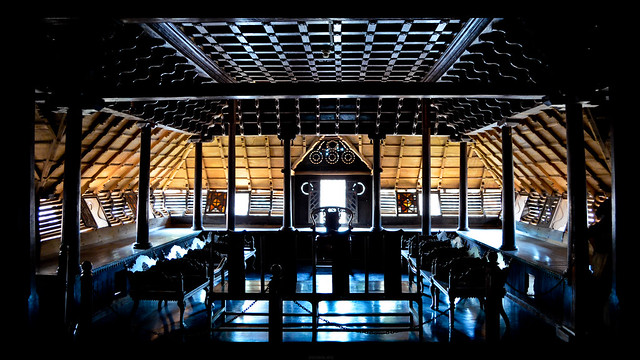After the Malayalam flick 'Amen', Kumarankary -a tiny village 3km from Changanassery town got famous. I can't help writing about Kumarankary as I was born there! My mother hails from Kumarankary and I grew up hearing stories of Kuttanadu from her. I spent every summer vacation (two months) helping my relatives in daily chores of farming at Kumarankary. Though 'Amen' refers to this village, the movie was NOT shot here. Interestingly, it was shot at Olavaipu, another tiny village in Alappuzha near Ernakulam border. Like in the movie Amen, the social life of Christians was centred around the church with its annual feasts featuring cultural programs. I remember listening Kadhaprasangam (story telling performance).
The only infrastructure in Kumarankary is a church- St. Mary's Church. There is absolutely no other facilities here! Not a even a toddy shop!! There used to be a grocery store and a ration shop (PDS), now only the ration shop remains. With a declining population as most of the old generation had migrated to bigger towns or abroad. The roads to Kumarankary were laid circa 2002. Until then, SWTD (State Water Transport Department) boats were the only way to reach here. During my childhood, we used to take a boat from Alappuzha for a three hour ride to Kumarankary packing our breakfast. There was not even a bicycle used until recently. Annual floods during the monsoon was so common until 2007, so learning swimming was inevitable if you lived in Kumarankary.
 |
| tatkalticket.in |
To retrace this route, reliving those sweet memories of childhood, Megha and I took a boat from Alappuzha to Changanassery (Rs 11, 3hrs) starting at 1:30pm. SWTD has not revised the ticket prices in the last 15years!! They are about to be revised in July 2013. The route is Punchiri-Vattakayal-Kaavaalam-Lissieu-Veliyanadu-Kidangara-Changanassery. You will cross the Vattakayal along the R-block on your right side. QST and R-block Kayal (lake) are known for its indigenous agricultural methodology, farming at a few feet below the sea level. Extensive land has been reclaimed from the backwaters and is protected by mud quay built around. Most of the houses along the paddy fields are abandoned now. When we were about to turn from Vattakayal, copious rainfall and a thunderstorm halted our journey for sometime. The dark clouds from a faraway distance rushed in a few seconds even before we could pull down window sheets of the boat. After Lissieu, there were many school kids to give us company. Curious about us, they asked our names practising the basic English lessons they learned.
 |
| tatkalticket.in |
We enjoyed the company of the kids- John and Jose for next few days relishing the culinary expertise of my aunts. Avalose podi (Roasted Rice Powder), Idiyappam (String hoppers), Kadumanga Achar (Fresh Mango Pickle) were the favourites of the various dishes lined up on the dining table from time to time. You can drive around this route by turning left at Kidangara from the scenic Alappuzha-Changanassery road. You can get back to Changanassery driving through Veliyanadu, Kunnamkary, Kumarankary, Paraal.
Alappuzha- Kottayam: The boat from Alappuzha left at 2:30 for its 2.5hrs ride to Kottayam (Rs 9)!! Right now, there is a bridge construction at Kanjiram, you have to stop here. You get a private bus from Kanjiram to Kottayam town- alight at Elanjickal if you are heading to Kumarakom.
 |
| The Hindu |
Mural City Kottayam: Most interesting would be the the Noah’s Ark on a 3000 sq.ft.wall of the St Joseph Church at Thellkom. Other spots to witness the artwork by various artists from around the world are: The gates of municipal ground at Thirunakkara, Sree mahadevar temple, Kottayam railway station, Knanaya Jacobite Valiapally, District Panchayat Office, CMS College, Press Club, Sreekrishna Swamy Temple; Darsana Cultural Centre and Sreemahadevar Temple, Nagambadom. Traditionally Mural Paintings (Chuvarchithram) involves only five colors- red, yellow, green, black and white -known as Panchavarna. The maintenance of these invaluable artwork is a question to be answered by time. Hurry if you want to watch before the monsoon rains affect them.



